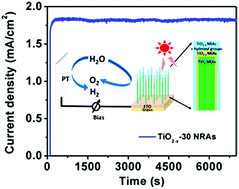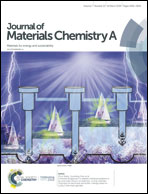Thermal vacuum de-oxygenation and post oxidation of TiO2 nanorod arrays for enhanced photoelectrochemical properties†
Abstract
Titanium dioxide (TiO2) is a promising photoelectrode material in photoelectrochemical (PEC) cells for generating hydrogen, which is an ideal green energy carrier as it is stable, abundant, and non-toxic. However, its large band gap still forms an obstacle in the practical applications of TiO2. Achieving reduced TiO2 (TiO2−x) is regarded as a good solution. In this study, we report an efficient approach to synthesize TiO2−x by vacuum annealing. The obtained TiO2−x nanorod arrays (NRAs) were covered with a thin amorphous layer after annealing at 500 °C for 4 h, showing good photoresponse in both ultraviolet and visible light regions. The NRAs possessed narrowed band gap, increased donor density, reduced charge transport and transfer resistance and exhibited a photocurrent density of 1.62 mA cm−2 at the bias of 1.23 V vs. reversible hydrogen electrode, which is superior to that of pristine TiO2 NRAs (0.81 mA cm−2). Moreover, the light-induced post passivation further improved the photocurrent density to 1.82 mA cm−2. The X-ray photoelectron spectroscopy and PEC measurements revealed that the enhancement was due to the formation of hydroxyl radicals at the surface and increased utilization of the irradiated light. Consequently, the facile vacuum annealing method has been proven to boost the PEC performance of TiO2 NRAs and could be a promising approach for enhancing the photocatalytic activity of other metal oxide semiconductors.



 Please wait while we load your content...
Please wait while we load your content...